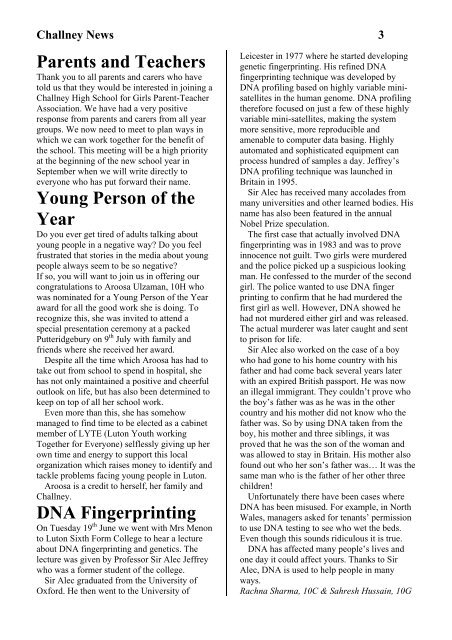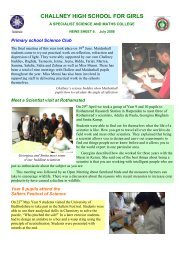The Gazette - Challney High School for Girls
The Gazette - Challney High School for Girls
The Gazette - Challney High School for Girls
Create successful ePaper yourself
Turn your PDF publications into a flip-book with our unique Google optimized e-Paper software.
<strong>Challney</strong> News 3<br />
Parents and Teachers<br />
Thank you to all parents and carers who have<br />
told us that they would be interested in joining a<br />
<strong>Challney</strong> <strong>High</strong> <strong>School</strong> <strong>for</strong> <strong>Girls</strong> Parent-Teacher<br />
Association. We have had a very positive<br />
response from parents and carers from all year<br />
groups. We now need to meet to plan ways in<br />
which we can work together <strong>for</strong> the benefit of<br />
the school. This meeting will be a high priority<br />
at the beginning of the new school year in<br />
September when we will write directly to<br />
everyone who has put <strong>for</strong>ward their name.<br />
Young Person of the<br />
Year<br />
Do you ever get tired of adults talking about<br />
young people in a negative way? Do you feel<br />
frustrated that stories in the media about young<br />
people always seem to be so negative?<br />
If so, you will want to join us in offering our<br />
congratulations to Aroosa Ulzaman, 10H who<br />
was nominated <strong>for</strong> a Young Person of the Year<br />
award <strong>for</strong> all the good work she is doing. To<br />
recognize this, she was invited to attend a<br />
special presentation ceremony at a packed<br />
Putteridgebury on 9 th July with family and<br />
friends where she received her award.<br />
Despite all the time which Aroosa has had to<br />
take out from school to spend in hospital, she<br />
has not only maintained a positive and cheerful<br />
outlook on life, but has also been determined to<br />
keep on top of all her school work.<br />
Even more than this, she has somehow<br />
managed to find time to be elected as a cabinet<br />
member of LYTE (Luton Youth working<br />
Together <strong>for</strong> Everyone) selflessly giving up her<br />
own time and energy to support this local<br />
organization which raises money to identify and<br />
tackle problems facing young people in Luton.<br />
Aroosa is a credit to herself, her family and<br />
<strong>Challney</strong>.<br />
DNA Fingerprinting<br />
On Tuesday 19 th June we went with Mrs Menon<br />
to Luton Sixth Form College to hear a lecture<br />
about DNA fingerprinting and genetics. <strong>The</strong><br />
lecture was given by Professor Sir Alec Jeffrey<br />
who was a <strong>for</strong>mer student of the college.<br />
Sir Alec graduated from the University of<br />
Ox<strong>for</strong>d. He then went to the University of<br />
Leicester in 1977 where he started developing<br />
genetic fingerprinting. His refined DNA<br />
fingerprinting technique was developed by<br />
DNA profiling based on highly variable minisatellites<br />
in the human genome. DNA profiling<br />
there<strong>for</strong>e focused on just a few of these highly<br />
variable mini-satellites, making the system<br />
more sensitive, more reproducible and<br />
amenable to computer data basing. <strong>High</strong>ly<br />
automated and sophisticated equipment can<br />
process hundred of samples a day. Jeffrey’s<br />
DNA profiling technique was launched in<br />
Britain in 1995.<br />
Sir Alec has received many accolades from<br />
many universities and other learned bodies. His<br />
name has also been featured in the annual<br />
Nobel Prize speculation.<br />
<strong>The</strong> first case that actually involved DNA<br />
fingerprinting was in 1983 and was to prove<br />
innocence not guilt. Two girls were murdered<br />
and the police picked up a suspicious looking<br />
man. He confessed to the murder of the second<br />
girl. <strong>The</strong> police wanted to use DNA finger<br />
printing to confirm that he had murdered the<br />
first girl as well. However, DNA showed he<br />
had not murdered either girl and was released.<br />
<strong>The</strong> actual murderer was later caught and sent<br />
to prison <strong>for</strong> life.<br />
Sir Alec also worked on the case of a boy<br />
who had gone to his home country with his<br />
father and had come back several years later<br />
with an expired British passport. He was now<br />
an illegal immigrant. <strong>The</strong>y couldn’t prove who<br />
the boy’s father was as he was in the other<br />
country and his mother did not know who the<br />
father was. So by using DNA taken from the<br />
boy, his mother and three siblings, it was<br />
proved that he was the son of the woman and<br />
was allowed to stay in Britain. His mother also<br />
found out who her son’s father was… It was the<br />
same man who is the father of her other three<br />
children!<br />
Un<strong>for</strong>tunately there have been cases where<br />
DNA has been misused. For example, in North<br />
Wales, managers asked <strong>for</strong> tenants’ permission<br />
to use DNA testing to see who wet the beds.<br />
Even though this sounds ridiculous it is true.<br />
DNA has affected many people’s lives and<br />
one day it could affect yours. Thanks to Sir<br />
Alec, DNA is used to help people in many<br />
ways.<br />
Rachna Sharma, 10C & Sahresh Hussain, 10G





